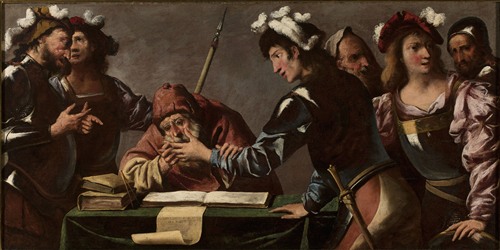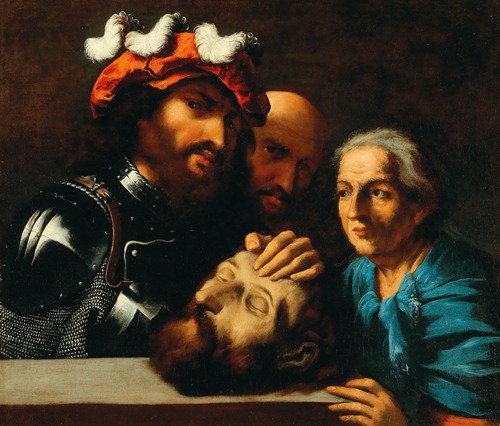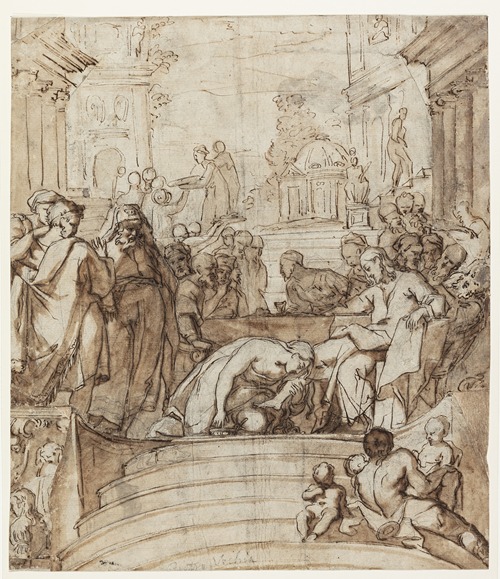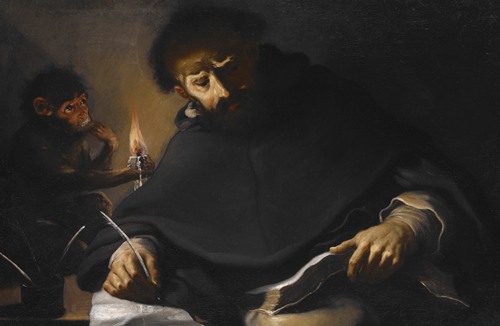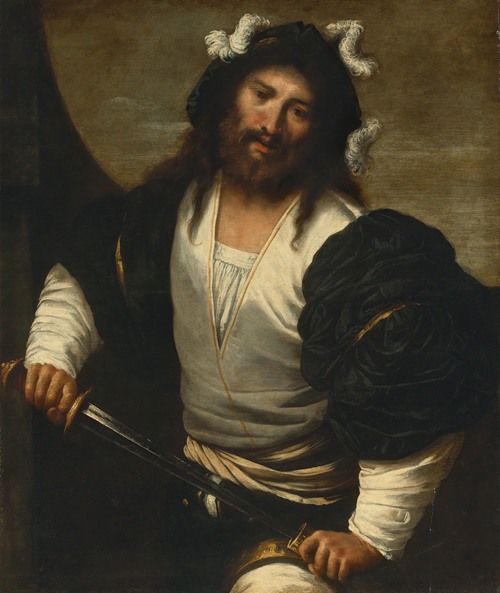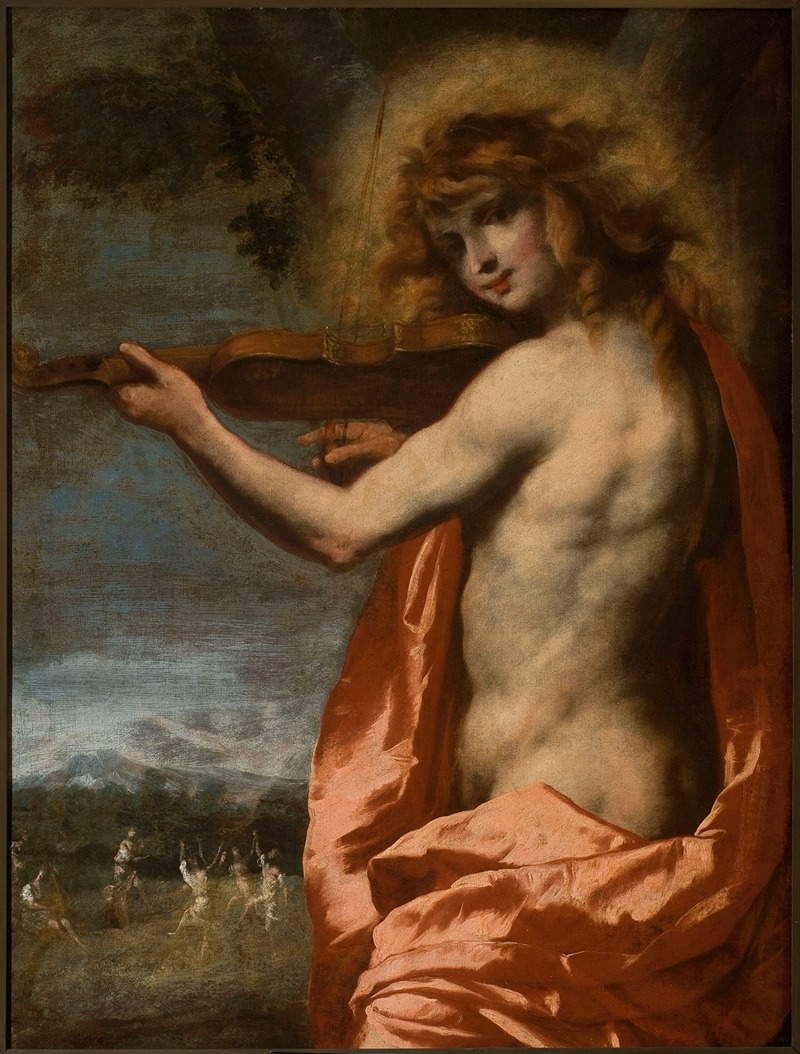
Pietro della Vecchia, Pietro della Vècchia or Pietro Vècchia, formerly incorrectly called Pietro Muttoni was a versatile Italian painter who worked in many genres and created altarpieces, portraits, genre scenes and grotesques. He also created pastiches of the work of leading Italian painters of the 16th century. He designed cartoons for mosaics and worked as an art restorer. Della Vecchia was also sought after as an art expert and did expert valuations of artworks. He worked most of his life in Venice and its environs except for a brief stay in Rome.
The life of Pietro della Vecchia is not very well documented and the information available is not always reliable. He is believed to have been born in Vicenza in 1603 as the son of Gasparo della Vecchia, who was a painter admitted to the Venetian painters guild. Some art historians place the artist's place of birth in Venice. Pietro della Vecchia was erroneously called Pietro Muttoni after Luigi Lanzi in the first edition of his Storia pittorica della Italia (1796), mixed up the artist's name with that of a Muttoni collection, which kept one of his paintings. Later authors interpreted de la Vecchia (meaning 'of the old') as a nickname as the artist liked to imitate the old masters of the previous century. Pietro was in fact a scion of a well-known Venetian family called 'Dalla Vecchia'.
Early sources describe Alessandro Varotari, called il Padovanino, as his teacher. On stylistic grounds some art historians have expressed doubt on this traineeship in his early years. The influence of the works of Padovanino is only visible after 1635. So he may have worked with Padovanino at a later stage. His earliest known work show a strong influence by Carlo Saraceni and Saraceni's pupil and collaborator Jean Leclerc. This is an important indication that della Vecchia trained with them. As his work displayed for some time certain Caravaggesque characteristics it is believed that he spent time in Rome after the departure of Leclerc from Venice in 1621 or 1622. Della Vecchia probably worked in Padovanino's workshop after his return from Rome in 1625 or 1626. Padovanino, whose style was strongly rooted in early-16th-century Venetian art, likely played an important role in instilling in della Vecchia a great interest in 16th-century painting in Venice and the Veneto.
The first documents in which the name of della Vecchia appears date back to the period from December 1626 to January 1628. The documents deal with the payment for a banner the artist had made for the Confraternity of the Carmelites in the church of S. Marco in Pordenone. From 1629 to 1640 he was a member of the guild of painters in Venice. In 1626 he married Clorinda Régnier (or Clorinda Renieri), a daughter of the Flemish painter Nicolas Régnier (or Renieri). Clorinda Régnier was a painter in her own right and has been described as "a woman of great spirit, of great stature and of great adherence" (Tommaso Temanza, 1738). Lucrezia Régnier, the elder sister of della Vecchia's wife was married to Daniel van den Dyck, a Flemish painter active in Northern Italy. Della Vecchia, together with his brother-in-law Daniel van den Dyck and their respective spouses, painted wall decorations in the Palazzo Pesaro in Preganziol.
Towards the end of the 1630s della Vecchia had established his name as one of the leading painters of Venice, especially of religious works. In January 1640 the procurators of S. Marco de Supra, responsible for the decoration of St Mark's Basilica, commissioned from him two cartoons for mosaics. These appear to have been well received as della Vecchia was subsequently appointed Venice's "pitor ducal" (painter to the duke), a position he held until 1674, that is, until four years before his death. In this capacity he was responsible for the design of the new mosaics and the restoration of the old ones in the Basilica. Della Vecchia also received a commission to restore Giorgione's Castelfranco Madonna altarpiece in 1643-1644.
At the height of his career, della Vecchia was a very sought-after teacher with a large workshop employing many assistants. Della Vecchia also opened an academy in his house where live drawing classes were organised. Gregorio Lazzarini was one of his pupils probably shortly after 1667. Gregorio Lazzarini was later the teacher of Giovanni Battista Tiepolo. Della Vecchia also taught classes on the theory of art.
Della Vecchia enjoyed fame as a connoisseur of ancient drawings and paintings. Especially during the latter part of his life he was repeatedly consulted by collectors and merchants, often together with his father-in-law Nicolas Régnier. Both he and his father-in-law had business relations with Paolo del Sera, who was the art agent in Venice of Leopoldo de' Medici, an Italian cardinal, scholar, patron of the arts and the Governor of Siena. Marco Boschini, an engraver, art dealer and author who was a great admirer of della Vecchia, often joined the artist when he was asked to value paintings after 1670.
Della Vecchia was close to the humanistic and libertine circle around the Accademia degli Incogniti (Academy of the Unknowns), a learned society of freethinking intellectuals, mainly noblemen, that significantly influenced the cultural and political life of mid-17th-century Venice. Many of the subjects of his works were a reflection of the intellectual occupations of this influential Venetian society. For instance the charged eroticism in the Young couple is likely linked to the libertine attitudes of the Accademia.
His son Gasparo Prospero was born on 8 May 1653 and became a minor painter, musician, music theoretician and mathematician. Pietro della Vecchia also had four daughters one of whom died young.
Della Vecchia died on 8 September 1678 in Venice and was buried in the church of S. Canciano.


